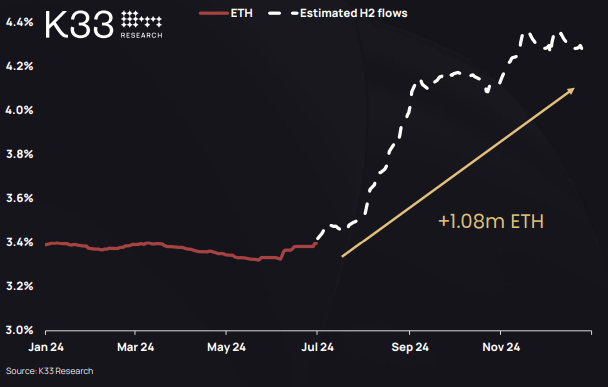Ethereum ETFs poised to defy market underpricing
|
- Ethereum investors are underpricing the impact of spot ETH ETF launch, says K33 Research.
- Grayscale's moves to reduce potential outflows for ETHE upon its ETF conversion.
- Ethereum could face sell-off if key indicator declines further.
Ethereum (ETH) is up 2% on Tuesday following predictions from K33 Research that investors are underpricing the upcoming ETH ETF launch. Meanwhile, Grayscale is making moves to reduce potential outflows from its Grayscale Ethereum Trust through its Ethereum Mini Trust.
Daily digest market movers: Underpriced ETH ETF, Grayscale's Mini Trust move
Ethereum has been the most popular crypto among traders in the past 24 hours after issuers submitted their amended spot ETH ETF S-1 registration statements with the Securities & Exchange Commission (SEC) on Monday. According to Santiment's data, recent discussions surrounding ETH appear to be bullish despite wider bearish sentiments across altcoins. Many analysts expect the ETFs to begin trading within/after two weeks.
The SEC approved issuers' spot ETH ETF 19b-4 filings in May but also needs to greenlight their S-1 drafts before the products can go live on exchanges.
While the current ETH price suggests that most traders aren't overly bullish on the ETH ETF launch, K33 Research analysts suggest in a recent report that the market is underpricing the impact of these products.
"We believe the market underappreciates the ETH ETF effect and forecast that US ETH ETFs will absorb 1% of the circulating ETH supply. We expect the ETH ETF effect to lead to ETH outperformance in H2 2024," said K33 Research analysts.
Percentage of circulating ETH supply held in investment vehicles
Meanwhile, Grayscale has announced a "record date" of July 18 for the initial creation and distribution of shares of its Ethereum Mini Trust to holders of the Grayscale Ethereum Trust (ETHE) ahead of its conversion when spot ETH ETFs launch. According to the announcement, Grayscale will contribute 10% of ETHE (about $500M-$600M) to the Mini Trust.
Considering Grayscale's Ethereum Mini Trust filings have yet to be approved by the SEC, the move could help reduce outflows for ETHE after its conversion to an ETF. "It looks like it effectively locks up 10% of ETHE NAV (net asset value) until the Mini-trust is approved for trading...reducing potential for outflows," said Scott Johnsson, general partner at Van Buren Capital.
If ETHE holders are anything like GBTC holders (perhaps a wrong assumption), Grayscale likely just took about $500-600M of outflows off the table in the first six months of ETH ETF trading. How that effects net flows is another question of course.
— Scott Johnsson (@SGJohnsson) July 8, 2024
If ETHE holders are anything like GBTC holders (perhaps a wrong assumption), Grayscale likely just took about $500-600M of outflows off the table in the first six months of ETH ETF trading. How that effects net flows is another question of course.
— Scott Johnsson (@SGJohnsson) July 8, 2024
ETH technical analysis: Ethereum STHs could determine ETH's next move
Ethereum is trading around $3,050 on Tuesday, up about 2% on the day. ETH's price sustaining above $3,000 has seen its short liquidations reach $18.30 million and long liquidations at just under $12 million in the past 24 hours, according to Coinglass data.
The liquidation data aligns ETH's Taker Buy Sell Ratio, which measures the number of buy orders versus sell orders. The ratio is at 1.004, indicating the bearish pressure has cooled.
Additionally, ETH's 180-day Market value to realized value ratio, which measures the profitability of all coins purchased in the last 180 days, is hovering around -5 %, meaning most short-term holders (STHs) are at a 5% loss. This is its lowest level since October. A further drop could cause panic among most STHs, who may sell off their tokens to cut losses.
On the flip side, the low MVRV indicates a potential buying opportunity ahead of the launch of spot ETH ETFs, which may propel ETH to new highs. If the ETFs prove successful, ETH faces resistance at $3,547, while the $2,852 level remains a key support level if bearish sentiment persists.
ETH/USDT 4-hour chart
ETH could rise to $3,104 in the short term to sweep a $3.78 million liquidation wall.
Ethereum FAQs
Ethereum is a decentralized open-source blockchain with smart contracts functionality. Serving as the basal network for the Ether (ETH) cryptocurrency, it is the second largest crypto and largest altcoin by market capitalization. The Ethereum network is tailored for scalability, programmability, security, and decentralization, attributes that make it popular among developers.
Ethereum uses decentralized blockchain technology, where developers can build and deploy applications that are independent of the central authority. To make this easier, the network has a programming language in place, which helps users create self-executing smart contracts. A smart contract is basically a code that can be verified and allows inter-user transactions.
Staking is a process where investors grow their portfolios by locking their assets for a specified duration instead of selling them. It is used by most blockchains, especially the ones that employ Proof-of-Stake (PoS) mechanism, with users earning rewards as an incentive for committing their tokens. For most long-term cryptocurrency holders, staking is a strategy to make passive income from your assets, putting them to work in exchange for reward generation.
Ethereum transitioned from a Proof-of-Work (PoW) to a Proof-of-Stake (PoS) mechanism in an event christened “The Merge.” The transformation came as the network wanted to achieve more security, cut down on energy consumption by 99.95%, and execute new scaling solutions with a possible threshold of 100,000 transactions per second. With PoS, there are less entry barriers for miners considering the reduced energy demands.
Information on these pages contains forward-looking statements that involve risks and uncertainties. Markets and instruments profiled on this page are for informational purposes only and should not in any way come across as a recommendation to buy or sell in these assets. You should do your own thorough research before making any investment decisions. FXStreet does not in any way guarantee that this information is free from mistakes, errors, or material misstatements. It also does not guarantee that this information is of a timely nature. Investing in Open Markets involves a great deal of risk, including the loss of all or a portion of your investment, as well as emotional distress. All risks, losses and costs associated with investing, including total loss of principal, are your responsibility. The views and opinions expressed in this article are those of the authors and do not necessarily reflect the official policy or position of FXStreet nor its advertisers.
